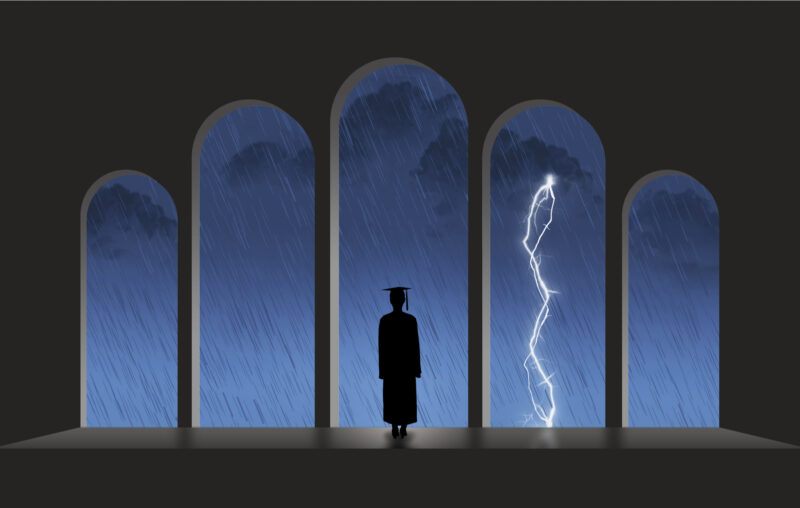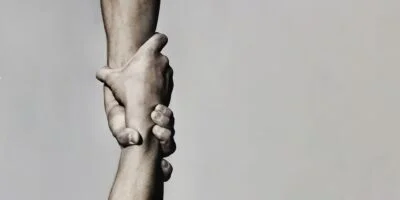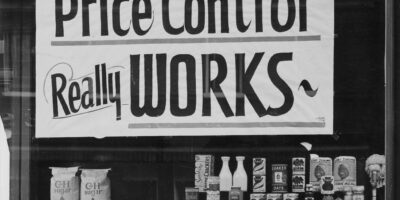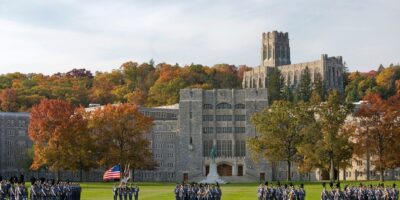Yes, Blame the Federal Student Loans

When I began working at the Cato Institute many moons ago, my focus was elementary and secondary education. But early on I came across a report titled “The College Cost Crisis,” from the U.S. House Committee on Education and the Workforce. The authors seemed exasperated that federal student aid never caught up with skyrocketing college prices—both kept rising. I thought the likely reason was pretty obvious: aid enables colleges to raise those prices. But as I pursued this possibility further, I was informed—not always politely—that this had been disproven long ago.
It turns out that no, it had not been disproven. Indeed, there is substantial empirical evidence that federal student aid fuels the ivory tower’s infamous price inflation, including roughly a doubling, in real terms, of sticker prices between the 1991-92 and 2021-22 school years. It also makes logical sense: If you give loads of people easy money to pay for one thing, the price of that thing will rise as people demand more of it, and with greater bells and whistles.
Unfortunately, statistical analyses and logic are abstract. They feel like ones and zeroes more than real people doing real things. Moving away from abstractions is where Debt Trap by Wall Street Journal reporter Josh Mitchell provides an immensely valuable service. It chronicles flesh-and-blood people, driven by combinations of good intentions and self-interest, creating and expanding federal student loan programs, and shows how those programs have distorted higher education and, for too many people, rendered it financially crippling.
Mitchell lays his book out in chronologically ordered chapters that lead with human interest anecdotes—student debtors, federal lending “entrepreneurs”—and that make it easy to comprehend the evolution of federal lending. From student aid champion President Lyndon Johnson’s difficulties paying for his own education at Southwest Texas State Teachers College in 1927—he needed a $75 loan and part-time work to stay enrolled—to the present day, Mitchell takes the reader through the life and times of federal student lending.
As one who was told in the Aughts that no one credible believed that student aid fueled skyrocketing college prices, Mitchell’s revealing that people have seen the problem since essentially Day One is gratifying. After Washington first created a program giving colleges money to lend to students in the wake of Russia’s 1957 Sputnik launch, Mitchell reports that the Eisenhower administration “suspected schools of inflating their needs,” asking for roughly double the amount the feds had projected.
Moving to the present day, the problem is still clear. Mitchell talks to Al Lord, twice-head of the federally created Student Loan Marketing Association—better known as Sallie Mae—who looking back on his career, and his grandkids’ current tuition bills, sees the problem. “Lord considers colleges greedy,” Mitchell writes, “charging exorbitant amounts while building up huge endowments to pay professors to work fewer hours and construct amenities to attract students.” More grudgingly, Lord acknowledges, the “education establishment” has had a “dependence…on government largesse.”
In between these examples, Mitchell writes about U.S. Secretary of Education William Bennett, who is important in this discussion if for no other reason than his name adorns the disparaged theory that I and many others think explains much of rampant college price inflation. Writing in the New York Times in 1987, under the headline “Our Greedy Colleges,” Bennett argued that student aid created a vicious cycle of more aid leading to higher prices, leading to the need for more aid. At least for those who spend time analyzing this phenomenon, it has ever since been called the “Bennett Hypothesis.”
When it comes to higher ed’s excesses—and there are many—Mitchell does not tear apart just one floor of the ivory tower. He tackles the terrible value proposition of many for-profit colleges—high prices for degrees of marginal value—as well as “Disney-fied” state universities that feature climbing walls, meticulously manicured lawns, and other pricey gilding. He also lays into putatively nonprofit private colleges, though they do not get their own themed chapters as the other institutions do.
Repeatedly, Mitchell calls federal student lending, which at its peak around 2010 was used by nearly 56 percent of full-time, full-year college students, what it is: unintended consequences run amok. “Many people…played a role in creating this mess,” Mitchell explains. “Most had good intentions, putting their faith in higher education and student loans as they sought to uplift families and the country. Many now say they got it wrong.”
As powerful—and, as a bonus, easy to read—as this book is, it is not perfect.
For one thing, it likely overstates the benefits of greatly increasing the share of people going to college. Mitchell writes that “the education of America’s workforce propelled the U.S. to become the world’s most prosperous nation in the latter half of the 20th century.” He offers little evidence to support that claim, which assumes that more degrees, or time in school, yields greater, more productive human capital.
Significant evidence suggests otherwise.
For instance, while we do not have long-term, comparable-over-time data for what degree-holders know and can do, we do have two small examples of comparable data over time that suggest that rising attainment does not translate into commensurately greater human capital. Both the National Assessment of Adult Literacy, administered in 1992 and 2003, and the Program for the International Assessment of Adult Literacy, administered in 2012/14 and 2017, found decreasing literacy rates for Americans with education beyond high school as attainment rose. This suggests that more college often results in more sheepskins, not more productive skills and knowledge.
We also have evidence that students have spent less time engaged in academic work over the decades. As Richard Arum and Josipa Roksa discussed in Academically Adrift: Limited Learning on College Campuses, the time spent studying by full-time students dropped from roughly 25 hours per week in 1961, to 20 hours in 1980, to 13 hours in 2003. Of course, students need time to soak in the nearest on-campus lazy river—part of that gilding for which Mitchell rightly takes schools to task.
Another indicator that more people spending more time in college does not necessarily represent greater acquisition of economically valuable skills and knowledge is “credential inflation:” a need for higher degrees just to stay in one labor-market place. Mitchell discusses the phenomenon, in which aid prompts more people to attain increasingly hollow degrees, enabling employers to demand credentials for which they did not previously ask and requiring potential employees to get higher degrees to distinguish themselves. It is another reason that we should hesitate to assume more college credentials contribute to greater economic growth.
Substantial existing literature directly addresses the assumption that more higher education produces greater human capital and economic growth. Economic historian Richard Vedder, for instance, has shown that despite a common assumption that the Morrill Act of 1862, which provided federal land-grants to fund public colleges, spurred major economic growth, growth was greater before the Act than after. Indeed, preexisting economic growth may well have enabled expansion of higher ed, not vice versa.
On an individual level, employers may value degrees as signals of basic personal attributes, such as following rules and personal discipline, much more than as indicators of specific skills and knowledge that degree-holders obtained in school. For instance, as economist Bryan Caplan presented in his 2018 book The Case Against Education: Why the Education System is a Waste of Time and Money, financial returns to education spike considerably when someone completes a credential compared to additional years of education not resulting in a credential. Were employers primarily concerned with prospective employees’ actual skills and knowledge, returns should not spike with a credential, but increase roughly equally for every additional year of schooling.
Mitchell may also give too dire an impression of the impact of federal student loans, a problem that has long marred media coverage of student debt. While the stories of people like “Lisa” and “Brandon” (I’m not sure if those are their real names) put important human faces on student debt, they may also be a bit misleading.
Lisa owed more than $120,000 after completing her Ph.D. But that is not representative of federal student debtors; according to the most recent data, less than 8 percent owe that much or more. Lisa also attended private, nonprofit institutions, which tend to be more expensive than public colleges, for her entire higher education experience. While easily accessible student loans enabled her to do this, the programs cannot be blamed entirely, or maybe even mostly, for her choices.
For his part, Brandon took on $100,000 in debt via a mix of federal loans and Sallie Mae private loans for his undergraduate studies at Howard University. Again, that is outlier debt—the average student with debt graduating in 2020 owed about $30,000—and Brandon could have chosen a less expensive option.
Finally, it is worth remembering that debt for a degree can still be a good investment. If you have a good chance of completing your program, do so in a field in demand in the labor market, and attend an institution with a decent reputation, you will likely do fine. The lifetime earnings premium for someone with a four-year college degree versus someone with just a high school diploma or GED is currently estimated at about $1.2 million.
As important as all this context is, it does not detract from by far the most important message of Mitchell’s fascinating and highly readable book: federal student lending, often fueled by good intentions, is “help” that has very often hurt.
Reprinted from Law & Liberty










